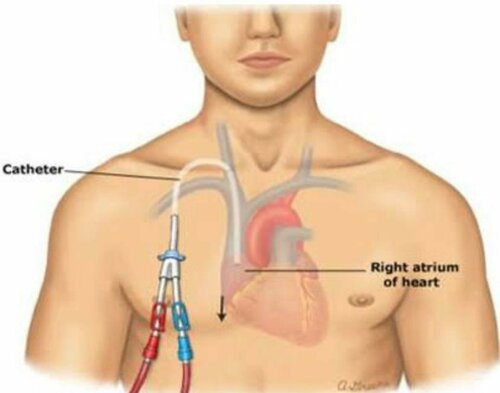What happens in a Permacath Insertion?
A Permacath insertion is the placement of a special IV line into the blood vessel in your neck or upper chest just under the collarbone. This type of catheter is used for short-term dialysis treatment. The catheter is then threaded into the right side of your heart (right atrium). The procedure involves creating a tunnel under the skin to thread the other portion of the catheter out through the skin. This tunneling process greatly reduces the risk of an infection and allows the catheter to remain in for a long period of time (one-12 months). The procedure involves complete sterility and the physician, nurse and X-ray tech will wear a mask, sterile gown and lead apron. A nurse will start an IV in your hand or arm and complete the history questionnaire. You will be given sedation through the IV, and the physician will scrub the area on the right or left chest or neck with a Chlorhexadine solution. The physician will ask you to turn your head to the other side while he places a drape over your face and neck to keep the area sterile. The physician will numb your skin with Lidocaine and you will be asked throughout the procedure if you are having any pain. Please tell the nurse or physician and more sedation and pain medication will be given. You will feel some pressure on your neck. The procedure will take 15-45 minutes. After the procedure, a dressing will be applied to cover the insertion site.

Patient Instructions Post Procedure ?
PLEASE do not shower or get the catheter wet.
- You may get into a bathtub, but only get wet to the nipple line (mid-chest).
- You will need to continue your routine dialysis treatments.
- Please inform your doctor of any fever or pain, redness or drainage at the catheter site.
- You may have a small amount of bleeding at the site. Report any bleeding that continues or increases to your physician.
- You may have mild pain for one to two days. You may take whatever pain medications you use for minor aches and pains.
How long will the catheter last?
The catheter will last anywhere from one-12 months depending on its care, your freedom from any infections and how long it needs to be used. The catheter is often used while a new graft is healing and as a temporary measure for short term (less than six months dialysis)
What should I do if it gets wet?
Getting the catheter wet greatly increases the risk of an infection at the catheter site by allowing germs to enter or contaminate the catheter. If the catheter becomes wet accidentally, promptly dry it off and cover it with dry sterile gauze dressing (available at any drug store). Notify your physician. Do not apply any antibiotic lotions or other cleaning solutions as they may damage the catheter and/or make it brittle and at higher risk for breaking.
